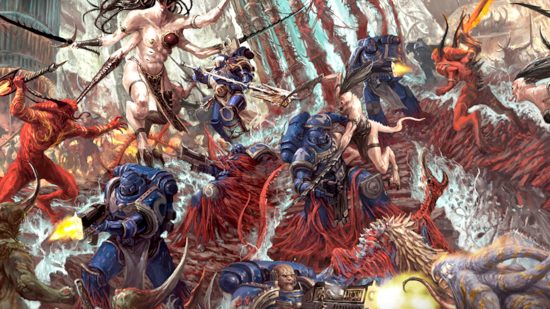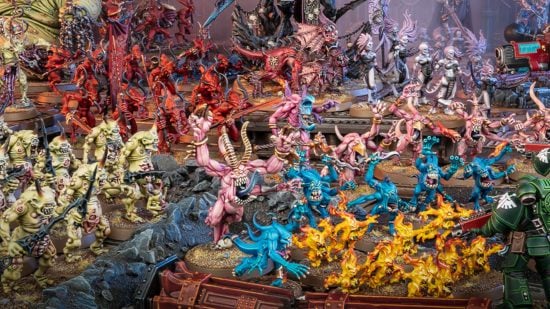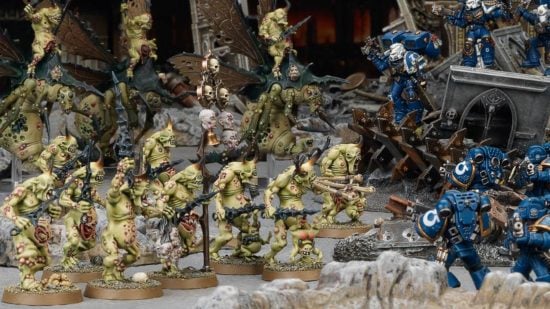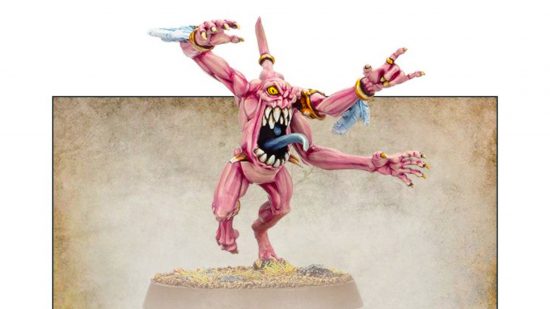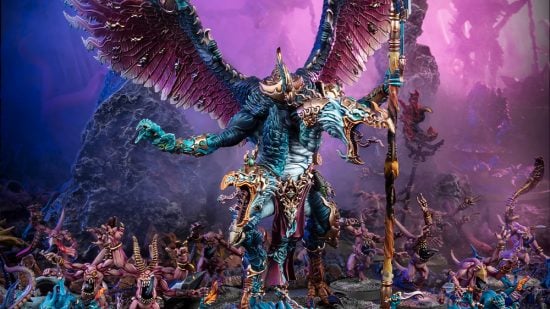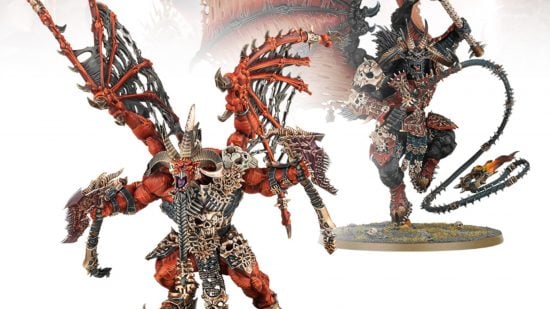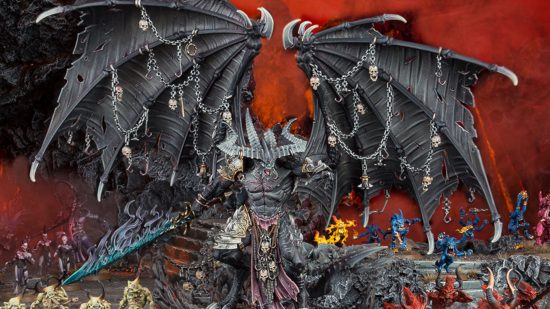In the grand scheme of Warhammer 40k Chaos Daemons are a strange faction. In Warhammer lore, they’re true horrors – numberless, evil, mutant foot soldiers of the apocalypse, itching to tear reality apart and eat it for breakfast. On the tabletop, though, they’ve often struggled to stake out an identity. This guide explains the types of daemons serving each of the chaos gods – and how to start collecting Chaos Daemons in the era of 40k 10th Edition.
Of all the Warhammer 40k factions, Chaos Daemons enjoy one of Games Workshop’s most diverse and characterful (if ageing) model ranges, as their roster is split into four distinct subfactions following the four Warhammer 40k chaos gods: Slaanesh, god of excess; Nurgle, god of plague; Tzeentch, god of fate and trickery; and Khorne, the blood god of murder.
- What are Chaos Daemons?
- Slaanesh Daemons
- Nurgle Daemons
- Tzeentch Daemons
- Khorne Daemons
- Daemon Princes
- How to start collecting Chaos Daemons in 2023
Each god commands legions of daemons that take wildly different forms appropriate to their patron deity’s general mien. As well as fighting in their own right, these tribes often march to war beside their particular god’s pledged legion of Chaos Space Marines: Nurglish daemons beside the Death Guard; Tzeentchians with the Thousand Sons; Khornate daemons with the World Eaters, and Slaaneshi creatures with the Emperor’s Children.
We’ll take a tour around each different god’s special flavor of Warhammer 40k Daemons in this guide. But first, if you’re already getting uncomfortable with the level of warp energy in the room, best get out now, and read our guides to the Imperium of Man, the Emperor of Mankind, or maybe the lovely Space Marines instead. Things are about to get really weird around here.
Still with us? Excellent – let the summoning ritual begin.
What are Chaos Daemons?
Let’s cover the basic lore first. In Warhammer 40k Chaos Daemons are creatures of the Warp, a.k.a. the Immaterium. They’re made not of normal matter, but the darkly reflected psychic energy of mortal beings – many of them are manifestations of specific psychic traits, like vengefulness, envy, or obsession.
This means two main things:
- They don’t belong in the ‘real’ world, and it takes a huge amount of psyker energy to keep them materialised in it.
- They can’t technically be ‘killed’ – destroy the daemon’s body in reality, and it will be reborn in the warp.
Most daemons can be considered self-interested individuals – but almost all of them are eternally pledged to one chaos god, locked in a never-ending rat race to gain power and get closer to their boss’ right hand (or tentacle).
Combine that with the fact the four chaos gods are constantly fighting each other for power, territory, and real-world influence in their infamous ‘Great Game’, and you’ll start to form a picture of daemonic existence.

It’s a land literally built from the stuff of mortals’ base instincts and dark secrets, where the only constants are unchained ambition and pure individualism, where morals (as we understand them) logically cannot exist, and the will to power is all. In Warhammer, Ayn Rand’s utopia exists – and it’s full of colorful creatures that want to nibble on your innards.
With that background out of the way, let’s explore the four chaos gods’ unique daemonic legions – from the lowliest, rank-and-file fiends right up to mightiest, most malevolent greater daemons.
Slaanesh Daemons
We’ll begin with the youngest chaos god, Slaanesh, the prince of pleasure – created in the death throes of the ancient Eldar empire as it was torn apart by its own hedonistic addiction to ever greater heights of perversion.
As creatures of psychic energy, not flesh, all Slaanesh Daemons reflect some aspect of their patron god’s essence: sin, excess, hedonism, sensation, temptation, obsession – but, above all, the deadly threats that lurk beneath mortal desire.
Lesser Daemons of Slaanesh
The Lesser Daemons of Slaanesh – making up the bulk of their armies – are:
| Type | Description | Battlefield role |
| Daemonettes | Svelte, androgynous, humanoid-animal hybrids with revealing clothes, iridescent lilac skin, and usually some crustacean or arachnid limbs | Fast-moving, light shock infantry |
| Fiends | Fierce, reptilian, centaur-like hunter beasts with a humanoid, breast-covered chest | Heavy-hitting elite linebreakers |
| Steeds | Dinosaur-like, bipedal reptile-horses, used as mounts by Daemonettes in Seekers units | Cavalry mounts & chariot pullers |
Greater Daemons of Slaanesh – Keeper of Secrets
The Greater Daemons of Slaanesh take the form of the Keepers of Secrets: towering, bull-headed, crab-clawed humanoid chimeras giving off vibes that are 50% satin boudoir, 50% sadistic slaughter.
Nurgle Daemons
Next, we turn to Grandfather Nurgle, god of plague, corruption, decay, and entropy. Nurgle Daemons, whether great or small, are all vectors of his many supernatural infections and maladies – not merely infected with them, but made of them; they’re creatures of pure disease who exist to spread the sickness.
Lesser Daemons of Nurgle
There are a fair few types of Lesser Daemons of Nurgle:
| Type | Description | Battlefield role |
| Nurglings | Tiny, capering, semi-sentient plague goblins that climb all over one another and swarm enemies | Fodder, screening, anti light infantry |
| Plaguebearers | Twisted, one-horned humanoids made of diseased flesh, endlessly counting as they shamble forward, armed with rusty blades | Horde infantry |
| Plague Drones / Rot Flies | Bus-sized, armored flies straight from Nurgle’s garden – called Plague Drones when ridden by Plaguebearers | Fast attack cavalry |
| Beasts of Nurgle | Lumbering, misshapen, tentacular creatures of pure disease who’re full of joy and just want to be your best friend | Heavy-hitting linebreakers |
Greater Daemons of Nurgle – Great Unclean Ones
As for the Grandfather’s greatest servants, the Greater Daemons of Nurgle are known lovingly as Great Unclean Ones.
In their form, they take closely after Papa Nurgle himself: Great Unclean Ones are vast, corpulent, vaguely humanoid mountains of rotting flesh and free-flowing pus. This ‘holy’ appearance shows off their scale and power in battle, but also signifies their stature and favor in Nurgle’s putrid court.
Tzeentch Daemons
Up next is Tzeentch, the Changer of the Ways, god of fate, trickery, ambition, hubris, and – importantly – power and sorcery. Tzeentch Daemons, too, take after their patron deity by being essentially formless, ever-changing, unpredictable, and deadly.
However, Tzeentch’s most powerful, ascended daemonic servants adopt avian (birdlike) features like feathers, sharp beaks, and talons, the better to embody their god’s twin themes of hidden wisdom and cruelty.
Lesser Daemons of Tzeentch
Most Lesser Daemons of Tzeentch are shapeless, ever-transforming, diminutive creatures known as ‘Horrors’. In generic fantasy terms, they’re ‘minor elementals’ – walking agglomerations of a particular strain of magic, able to change their shape and throw that magic at their foe in projectile form.
Their main gimmick is that when you kill a Horror, it splits into multiple smaller, different-colored Horrors, that are still trying to kill you. This makes for some humorous gameplay situations (at least, humorous for the Tzeentch player).
The more specialised forms, however, get more unnerving, otherworldly, and lethal real quick. By and large, it’s these stronger units – the Flamers and Screamers – that get the most work done in tabletop battles.
The types consist of:
| Type | Description | Battlefield role |
| Pink Horrors | Giggling, many-armed homunculi that throw colorful magical fireballs | Battleline troops / ranged skirmishers |
| Blue Horrors | Grumbling, many-armed homunculi that throw colorful magical fireballs | Battleline troops / ranged skirmishers |
| Flamers | Flying, writhing, fleshy tubes with fanged maws that belch torrents of magical fire | Elite anti-infantry damage dealers |
| Screamers | Flying, shrieking, many-toothed purple manta rays hungry for mortal flesh | Deadly, fast moving anti-infantry assassins |
Greater Daemons of Tzeentch – Lord of Change
A truly iconic Warhammer monster, the Greater Daemons of Tzeentch are called Lords of Change: terrifying, 20-foot-tall hybrids of human, reptile, and bird of prey who walk on their hind legs or fly on huge bird-wings, and channel the warp into potent psyker spells.
Khorne Daemons
Finally among the ruinous powers, we come to the blood god, the lord of murder, he of the skull throne: Khorne. Khorne Daemons, in the main, are about as simple to understand as he is: they’re red, they have horns, and they very much want to kill everything and everyone.
Lesser Daemons of Khorne
| Type | Description | Battlefield role |
| Bloodletters | Muscular, scaly, red-skinned humanoids with long, snake-like tongues and curved black horns | Hard-hitting melee infantry |
| Flesh Hounds | Half dog, half dinosaur, all terrifying | Fast moving skirmish cavalry |
| Juggernauts / Bloodcrushers | Huge, armored daemonic steeds that look like a cross between a direwolf and a scarlet mechanical bull – sometimes ridden by Bloodletter characters or World Eaters | Hard hitting, elite heavy cavalry |
Greater Daemons of Khorne – Bloodthirsters
The OG, the original, demonic Chaos Daemon – the Greater Daemon of Khorne is the screaming, red-skinned, bat-winged, goat-headed, axe-wielding avatar of destruction that is the Bloodthirster.
A part of Warhammer from its earliest days, the iconic Bloodthirster is murder incarnate, the epitome of brute strength, unchained aggression, and inhuman mercilessness. Its tabletop rules haven’t always reflected that fluff as closely as Khorne fans would hope – but hey, there’s always the next codex.
Daemon Princes
That covers all the pure-bred neverborn varieties for the four chaos gods (except for the multifarious types of daemonic beasts, but if we listed those we’d be here until Long Night). However, there’s another important type of Chaos Daemon entity you should know: the Daemon Prince.
Daemon Princes are mortal (usually human or Space Marine) champions of Chaos who have been transformed into daemons and given immortality as a denizen of the warp. Most are granted daemonhood by a specific chosen deity in return for loyal service, but some are bound to serve chaos undivided (so no god in particular).
While the very first of the Warhammer 40k Daemon Princes was Be’Lakor, the Dark Master (pictured above), they represent a wide range of characters, ranging from comparatively low-ranking princes who’re closer to up-jumped Chaos Space Marine lords, through to demigod-level combatants, such as the daemon primarchs of fallen Space Marine legions:
- Mortarion of the Death Guard
- Magnus of the Thousand Sons
- Angron of the World Eaters
- Fulgrim of the Emperor’s Children
- Lorgar of the Word Bearers
- Perturabo of the Iron Warriors
Key point, though: while a Warhammer 40k Chaos Daemons army can field the Daemon Prince unit, Mortarion, Magnus, and Angron are not part of the army; they belong with their respective factions.
While, in 10th Edition, any army with the Chaos keyword can take 25% of its points in daemon units, sadly it doesn’t work the other way around; you can no longer ‘ally in’ daemonic units from other factions (like Mortarion, or the various daemon engines used by the Death Guard and other Chaos Space Marines).
How to start collecting Chaos Daemons in 2023
We’ll be honest: of all the 40k armies to collect, Chaos Daemons are among the more expensive and troublesome to get going with at the moment.
Things get easier if you particularly fancy the scarlet-skinned skull-fanciers of Khorne, because the Chaos Daemons’ Warhammer 40k Combat Patrol (Games Workshop’s current, $160 per-faction starter sets) is loaded with Khorne Daemons.
That box gives you 34 miniatures total (at a decent discount versus buying the sets individually) including:
| Unit | Battlefield role | Number of models |
| Bloodmaster | HQ character | 1 |
| Bloodcrushers | Fast shock cavalry | 3 |
| Flesh Hounds | Harrying skirmishers | 10 |
| Bloodletters | Battleline | 20 |
Pick up two of those boxes, and you’ve got the makings of a decent Khorne army right there. If you’re more into one of the other gods, though… well, we’re afraid that’ll make your army-starting bill much higher.
Before the new Combat Patrols were phased out, GW used to sell ‘Start Collecting’ boxes for each of the four Chaos Daemons subfactions, but these have sadly gone the way of the dodo. If you’re lucky, you might find one of these online or lingering at your local game store – otherwise, you’ll have to cough up to buy the specific units you want piecemeal.
On the upside, though, that’s one of the big draws of the Chaos Daemons army: it’s one big, weird, terrifying patchwork quilt, and you can freely throw together a horde from whichever gods’ daemons you fancy.
This applies now more than ever, because, under the current “simplified, not simple” 10th edition index rules, there’s only one Warhammer 40k detachment choice available, and it really doesn’t provide any compelling strategic incentive to limit yourself to one god.
Until their Warhammer 40k codex comes out (which won’t be before Summer 2024), there’s really very little in the rules to say you shouldn’t mix and match to your heart’s content.
At a bare minimum, your initial shopping list should include:
- A character to be your Warlord
- At least two 20-model units of your core troops
- At least two fast moving cavalry units to dash ahead and take objectives
- At least one hard-hitting elite unit to reinforce your battleline troops once they’re in the fray, and possibly buff them too
And eventually, of course, you’re going to want a huge, impressive, very scary centerpiece unit: either a Greater Daemon of your favorite god, or perhaps Be’Lakor, the Dark Master.
And that’s all we have for you on the Warhammer 40k Chaos Daemons right now – we’ll be updating this guide soon with some detailed tips on how to play Chaos Daemons in 10th edition 40k.
In the meantime, check out our overall guide to Warhammer 40k Chaos forces, or – if you’re videogame inclined – read our guide to the best Warhammer 40k games for PC and console. Fans of grand strategy games and the Total War series might also like to follow our running estimate on when and how we might expect a Total War Warhammer 40k to emerge.

